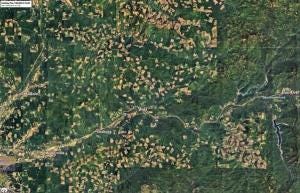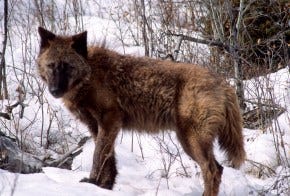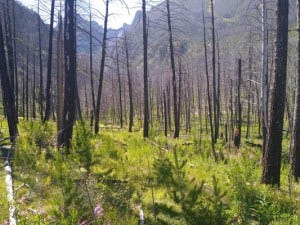Logging Degrades Forest Resilence
The Forest Service justifies much of its current logging on increasing resilence, but logging actually interfers with evolutionary agents that create healthy forest ecosystems.
“Thinning” project on the Wallowa Whitman NF in Oregon. The removal of trees by chainsaw medicine eliminates evolutionary agents that would otherwise naturally “thin” the forest. Photo George Wuerthner
The Forest Service and Forestry School researchers (funded by the Forest Service) continue to promote the idea that our forests are “unhealthy.” It is an example of the “Father Knows Best” philosophy that the agency and its researchers understand how to mend the forest. And, of course, it also assumes that the forest needs repairing.
Feller buncher cutting trees which the Forest Service asserts “improves forest resilency” while it ignores all the negatives of logging including spread of weeds, loss of biomass, loss of store carbon, disturbance to wildlife, and loss of genetic diversity, and other impacts. Photo George Wuerthner
The problem with the Forest Service’s current love affair with chainsaw medicine is that it assumes that anything that kills a tree (except a chainsaw) is undesirable.
The agency and its lackeys are like the snake oil salesman of old, promising that their magic elixir (logging) can cure whatever ails the forest, whether it is sick or not.
This Google photo shows the clearcuts that failed to stop the Holiday Farm Fire along the McKenzie River in Oregon that burned under extreme fire weather with 50 mph or greater winds. The second photo is the same area showing the clearcuts in the background–all of which burned. If a massive deforestation such as this did not stop the wildfire spread, how can anyone believe that thinning will achieve positive results.
We are told that chainsaw medicine treatments aim to reduce large, high-severity wildfires and enable trees to survive insects, drought, and disease.
The problem is that the above are the evolutionary factors that have maintained “healthy” forest communities for millennia. In a sense, these evolutionary agents select which trees are best adapted to current conditions (not some past historical situation that no longer exists).
Natural evolutionary agents like insects, disease, wildfire and drought are as the wolf to the deer or elk. They naturally thin the forest and create resielency. Photo George Wuerthner
To quote the poet, Robinson Jeffers, “What but the wolf’s tooth whittled so fine. The fleet limbs of the antelope?”
It is the same for our forests—wildfire, drought, insects, and disease are whittling the woodlands to withstand present and future challenges just as wolves select the least fit elk or deer for their prey, improving the species’ overall genetic health.
However, the Forest Service and OSU researchers have no idea which trees may have a genetic or physical trait that allows them to survive things like drought, wildfire, insects, and disease.
They are, in effect, with their chainsaw medicine interfering with evolution. That is a dangerous game to play.
Many genetic studies have shown that rare genetic alleles provide resilience to any population—including forests. Only one in a hundred or more individuals may possess these genetic features, and yet by removing a significant amount of the trees, the agency is degrading the forest’s resilience.
The snags that remain after a high severity fire creates habitat for numerous species and new ecological opportunities. Logging is no subsitute for natural evolutionary agents like wildfire. Photo George Wuerthner
A second problem with the current mantra to log our way to forest health is that large, high-severity wildfires provide the habitat for numerous other species. Some biologists estimate that at least half of all wildlife depend on the snags that result from large blazes for their homes. The snags that fall into streams supply the bulk of the habitat for fish. The snags and downwood that remain after a wildfire, drought, insect, or disease outbreak store carbon for centuries.
In short, the Forest Service cannot see the forest ecosystem through the trees due to its Industrial Forestry bias. The focus on individual trees fails to see the long-term consequences of its chainsaw medicine program.
Given the climate changes we are experiencing, the way to increase resilience in our forests is to allow evolution to operate. Our forest communities will change and adapt to the current climate, and part of this adaptation may be the loss of some trees, but in the end, our forest communities will be stronger.
Here’s an example of a home that is vulnerable to wildfire. Home hardening includes removal of debris from roof and gutters (like the pine needles in this photo), screening vents, removal of flammable materials adjacent to exterior walls, and install non-flammable roofing material. Photo George Wuerthner
In the meantime, the best way to protect communities is home hardening, not chainsaw medicine.








